Laptop Mag Verdict
Armed with Intel’s powerful Tiger Lake CPU and GPU, the Razer Book 13 makes a compelling case to productivity users.
Pros
- +
Powerful overall and graphics performance
- +
Plenty of ports
- +
Bright, vivid display
- +
Comfortable, customizable keyboard
Cons
- -
Runs a bit warm
- -
Sluggish file transfer
Why you can trust Laptop Mag
Over the years, Razer’s made some changes and slowly extended its reach outside of the gaming sphere. It started with Razer Blade Stealth, a sleek ultraportable that culminated into the Razer Book 13. Designed for productivity users, the Razer Book 13 is outfitted with an 11th Gen Core i7 processor, one of Intel’s powerful new Tiger Lake CPUs. It also has the new integrated Iris Xe Graphics, which, under the right conditions, can output some solid gaming performance.
But how does Razer’s bold step outside of the gaming laptop space hold up against established heavy-hitters in the productivity space? Read on to find out.
Price: $1,599
CPU: Intel Core 1165G7
GPU: Intel Iris Xe Graphics
RAM: 16GB
Storage: 256GB M.2 PCIe SSD
Display: 13.4-inch, 1920 x 1200, 60Hz
Battery: 11:44
Size: 11.6 x 7.8 x 0.6 inches
Weight: 3.1 pounds
Razer Book 13 pricing and configurations
The base model Razer Book 13 costs $1,199 and has a 2.4-GHz Intel Core i5-1135G7 processor with 8GB of RAM, a 256GB M.2 PCIe SSD, an Intel Iris Xe Graphics GPU and a 13.4-inch, 1920 x 1200-pixel, 60Hz display.
I took the $1,599 mid-tier iteration for a spin, which bumps the CPU to a 2.8-GHz Intel Core i7-1165G7 CPU, 16GB of RAM and a 13.4-inch, 1920 x 1200-pixel, 60Hz touchscreen. For $1,999 you get a 512GB M.2 PCIe SSD, and a 13.4-inch, 3840 x 2400-pixel, 60Hz touch panel.
Razer Book 13 design
A chassis made almost entirely of CNC aluminum? Check. A silver embossed tri-snake logo that gleams just the right amount when the light hits it? Check. This is definitely a Razer laptop. Instead of the usual inky black frame, the Razer Book makes its grand entrance in the company’s Mercury White color scheme, which helps it stand out from its gaming-centric brethren.
There are a few other aesthetic differences, namely the strip of rubberized plastic along the rear of the device and the small sliver outlining the bezel. A long slim cutout along the front of the laptop creates a subtle lip that makes opening the laptop an easy process.
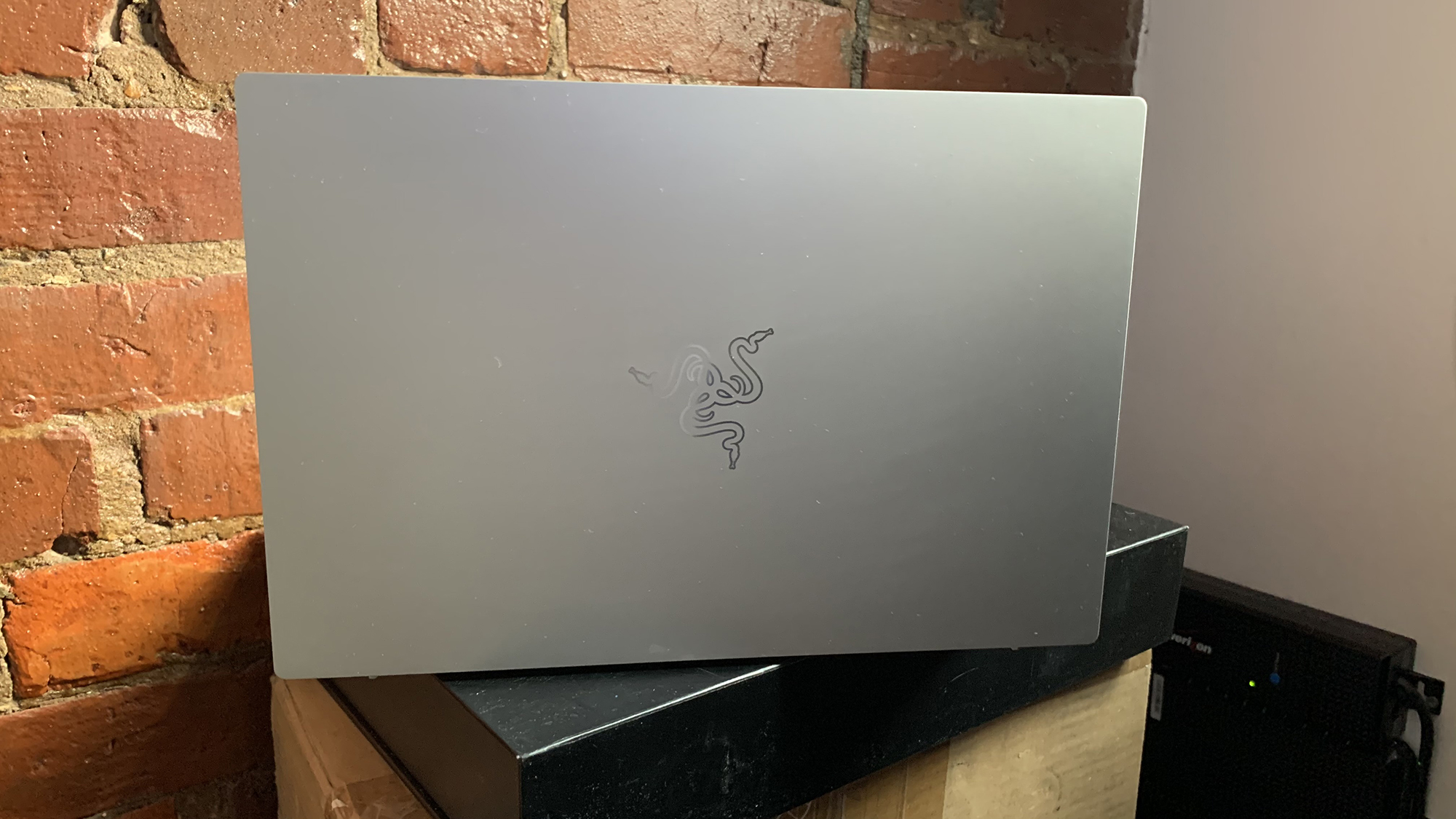
Upon opening the system, you’re treated to more of that lovely Mercury White CNC chassis. The island-style keyboard is colored white which creates a great contrast. The keyboard is nestled between two slim speakers and sits directly above the large touchpad.
Sign up to receive The Snapshot, a free special dispatch from Laptop Mag, in your inbox.
Measuring 11.6 x 7.8 x 0.6 inches the 3.1 pounds Razer Book 13 is heavier than the competition, including the Asus ZenBook 13 UX325EA (11.9 x 8 x 0.5 inches) which weighs 2.5 pounds. The Dell XPS 13 (11.6 x 7.8 x 0.6 inches) and Apple MacBook Pro M1 (11.9 x 8.4 x 0.2~0.6 inches) are also lighter at 2.8 pounds.
Razer Book 13 ports
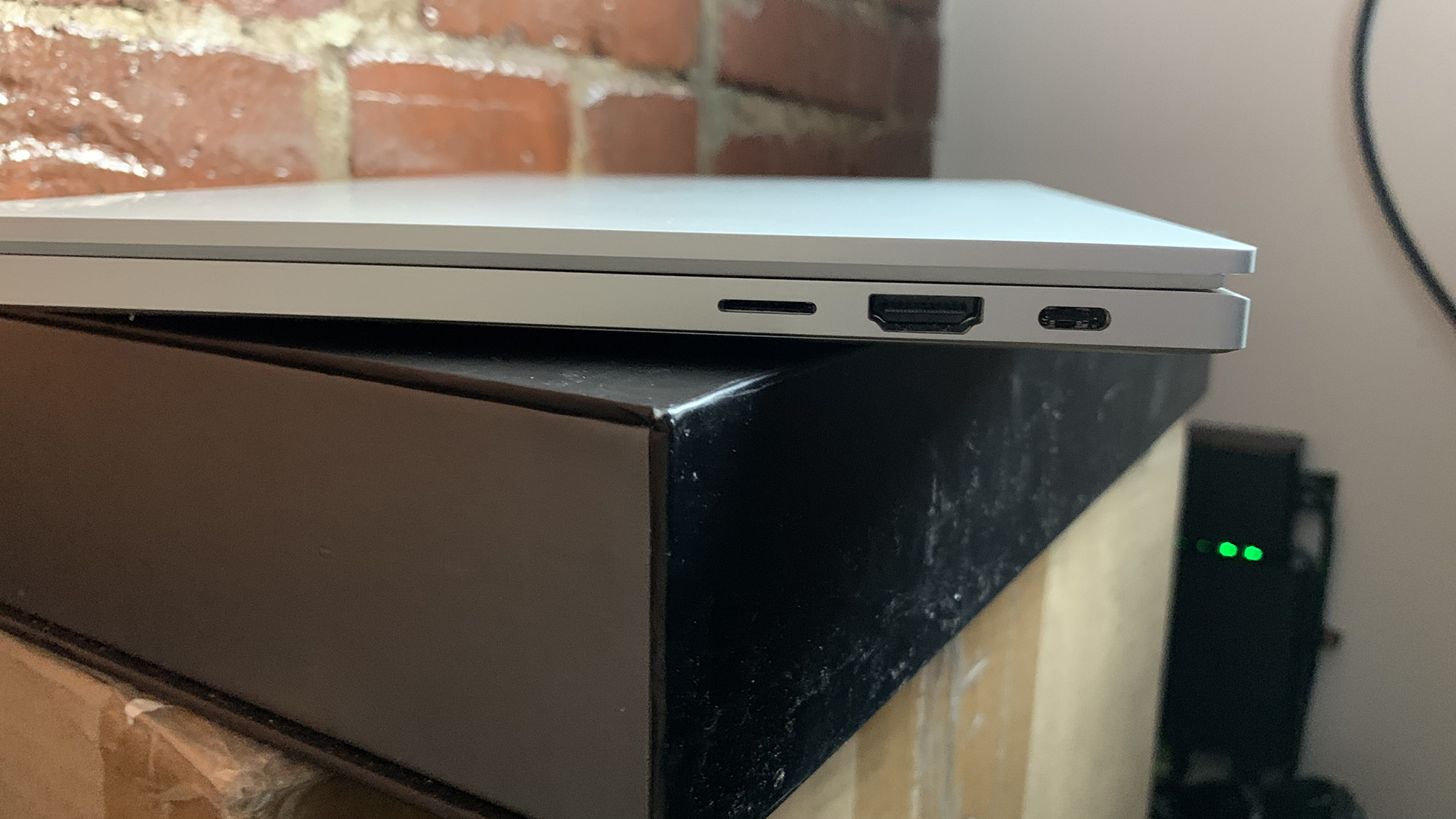
Unlike most ultraportables on the market, Razer isn’t skimping on the ports. On the right, you’ll find a Thunderbolt 4 port, an HDMI 2.0 and a microSD slot. There’s another Thunderbolt 4 port on the left with a USB 3.1 Gen 1 Type-A port and a headset jack.
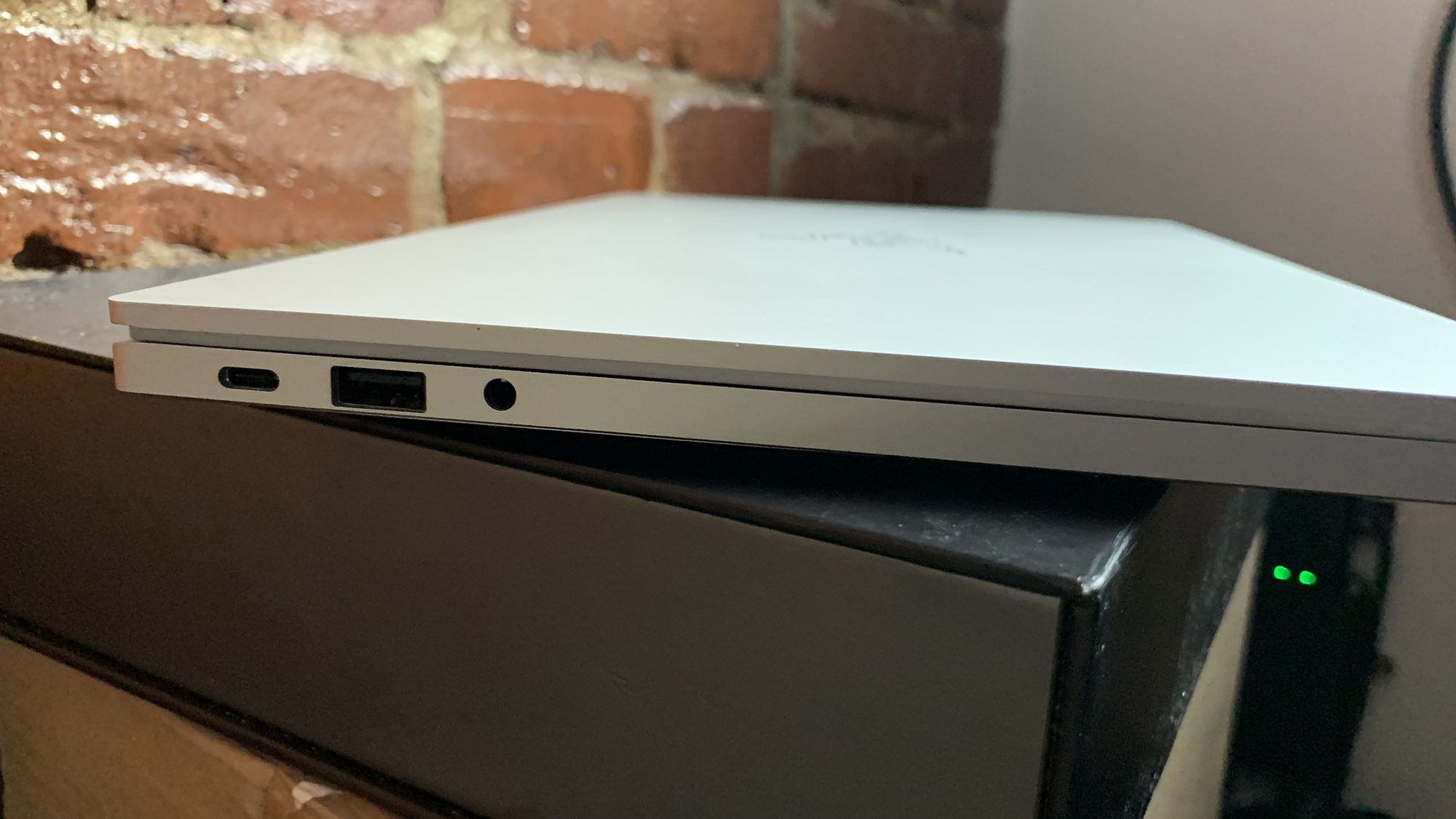
Razer Book 13 display
If there’s one thing Razer knows how to do, it’s serve up a beautiful display. I was tempted to spend all day watching Jingle Jangle and Big Mouth Season 4 on the 13.4-inch, 1920 x 1200-pixel, 60Hz touch display. But alas, I had work to do. I was impressed at the panel’s vividness when I watched the trailer for Yalda, A Night for Forgiveness.
The chairs, upholstered in crimson red velvet with golden frames immediately drew my eye and kept my focus. The more I gazed at the opulent furniture, I could see the different gradients in the fabric based on how the light hit. The tiny crystals outlining the gold frame sparkled, accentuating the tears flowing down the titular Yalda’s face.
Taking notes from Dell and others in the space, Razer has dramatically slimmed the bezels, to 0.2 inches. That enlarges the laptop’s display to a 16:10 aspect ratio, which gives viewers more real estate to enjoy.
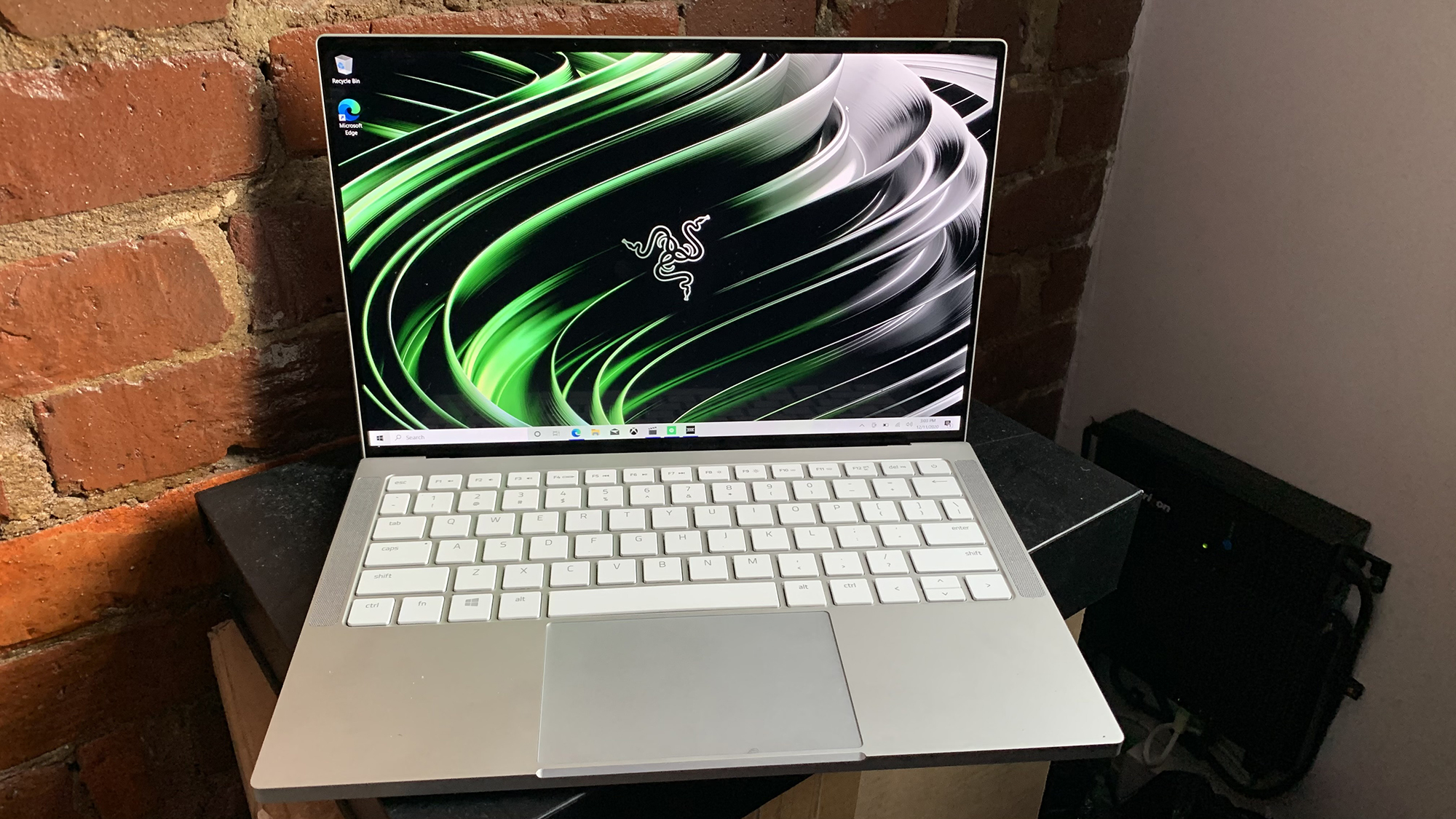
When we measured the display’s color reproduction capabilities, the Razer Book 13 delivered 80.7% of the DCI-P3 color gamut. It’s not as vibrant as the 85.5% premium laptop average, but it’s better than the MacBook Pro (78.3%), ZenBook 13 (76.1%) and XPS 13 (69.4%).
The Razer Book 13 is also plenty bright, averaging 436 nits and outshining the 388-nit category average as well as the MacBook Pro and ZenBook 13, which reached 435 nits and 370 nits, respectively. However, the XPS 13 was slightly brighter at 469 nits.
The 10-finger capacitive screen is agile and responsive and kept pace with my random doodles. The screen is made from Corning Gorilla Glass, so you don’t have to worry too much about damaging the panel. And while the 60Hz refresh rate isn’t as fast as a gaming laptop, if you were hankering to play a game, it’d be sufficient.
Razer Book 13 audio
You wouldn’t use the Razer Book 13’s quad speakers to play music at a house party, but they did a solid job filling my smallish living room with clear audio. Listening to Foxanne’s “So Excited,” I enjoyed the clarity of the electric guitars and drums. The soundstage was spacious, allowing the singer’s powerful vocals to shine as her gritty warbling took center stage.
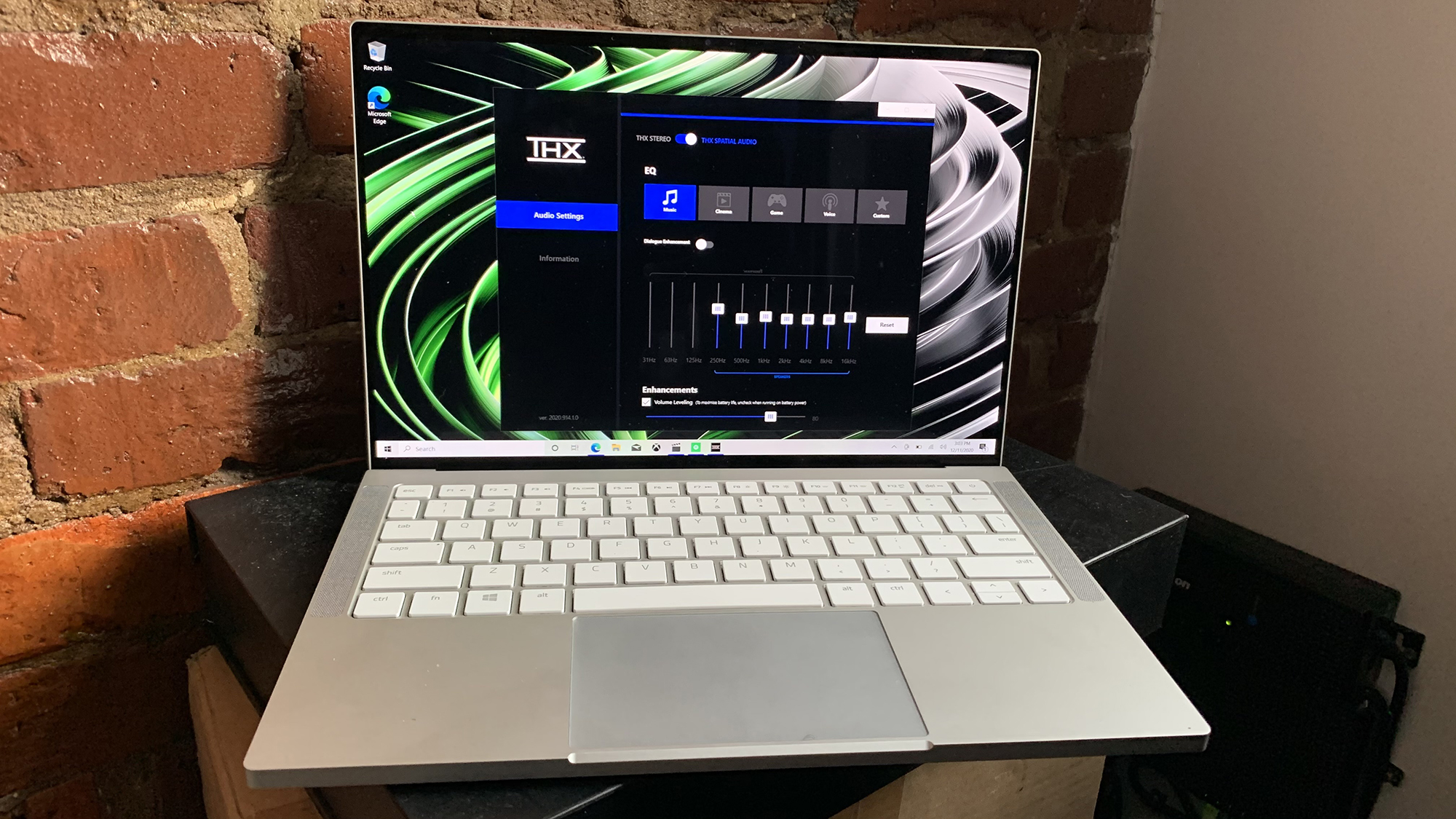
Razer is using that THX acquisition wisely, bringing the company’s audio expertise into the THX Spatial Audio for PC software. The software allows you to switch between THX Studio and THX Spatial. The Studio setting gives you the full-throated top-firing speaker experience, while Spatial diffuses the soundstage a bit to give an element of 360-degree sound. Add settings for Music, Game, Cinema, Voice and Custom and you’ve got some interesting audio. Currently, I prefer Spatial and Music as my default settings.
Razer Book 13 keyboard and touchpad
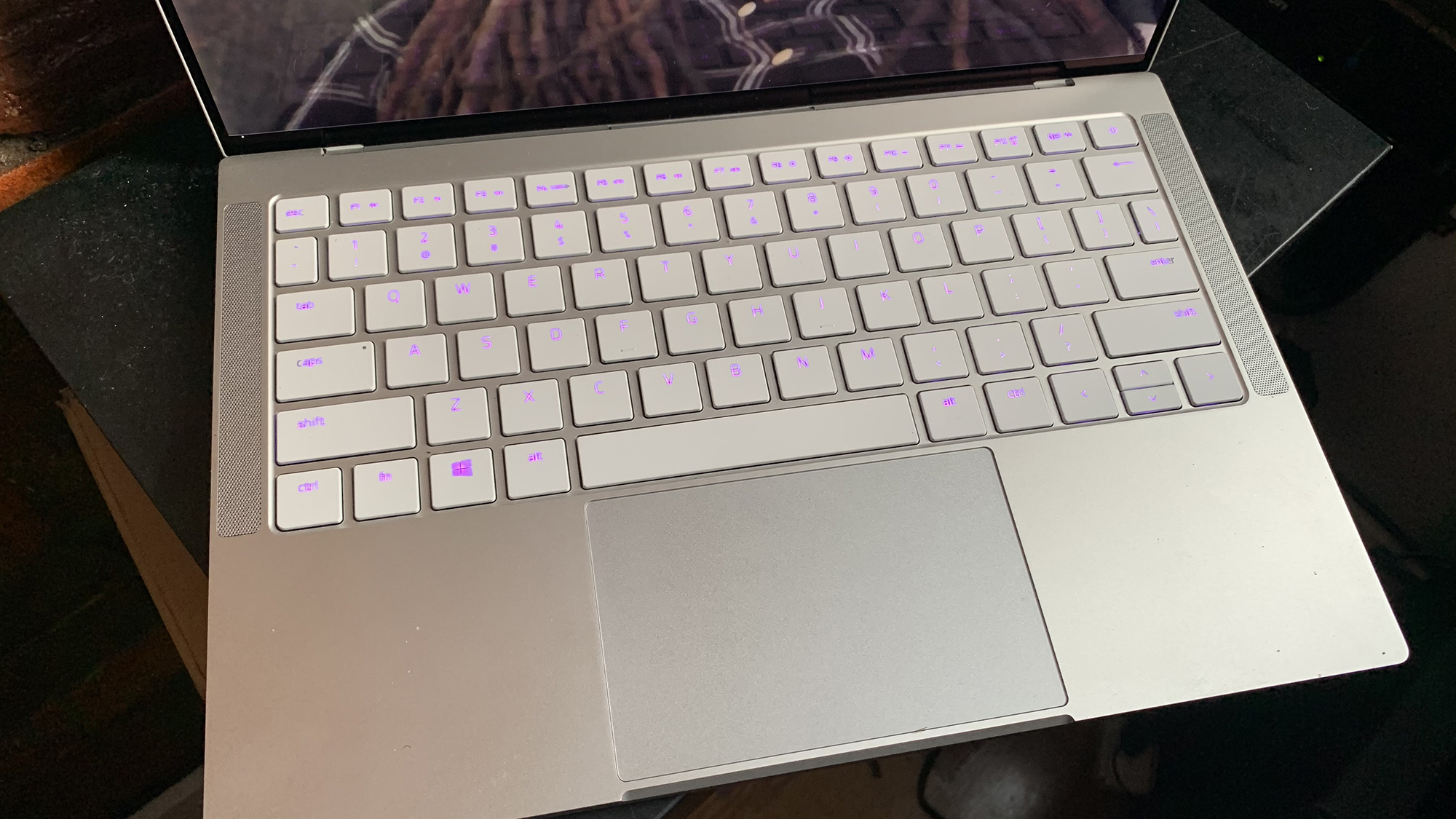
Like many other Razer laptops, the Razer Book 13 is outfitted with a Chiclet-style anti-ghosting keyboard with the company’s beautiful Chroma lighting. Capable of reproducing 16.8 million colors via Razer’s proprietary software allows for per-key programming for color and functionality.
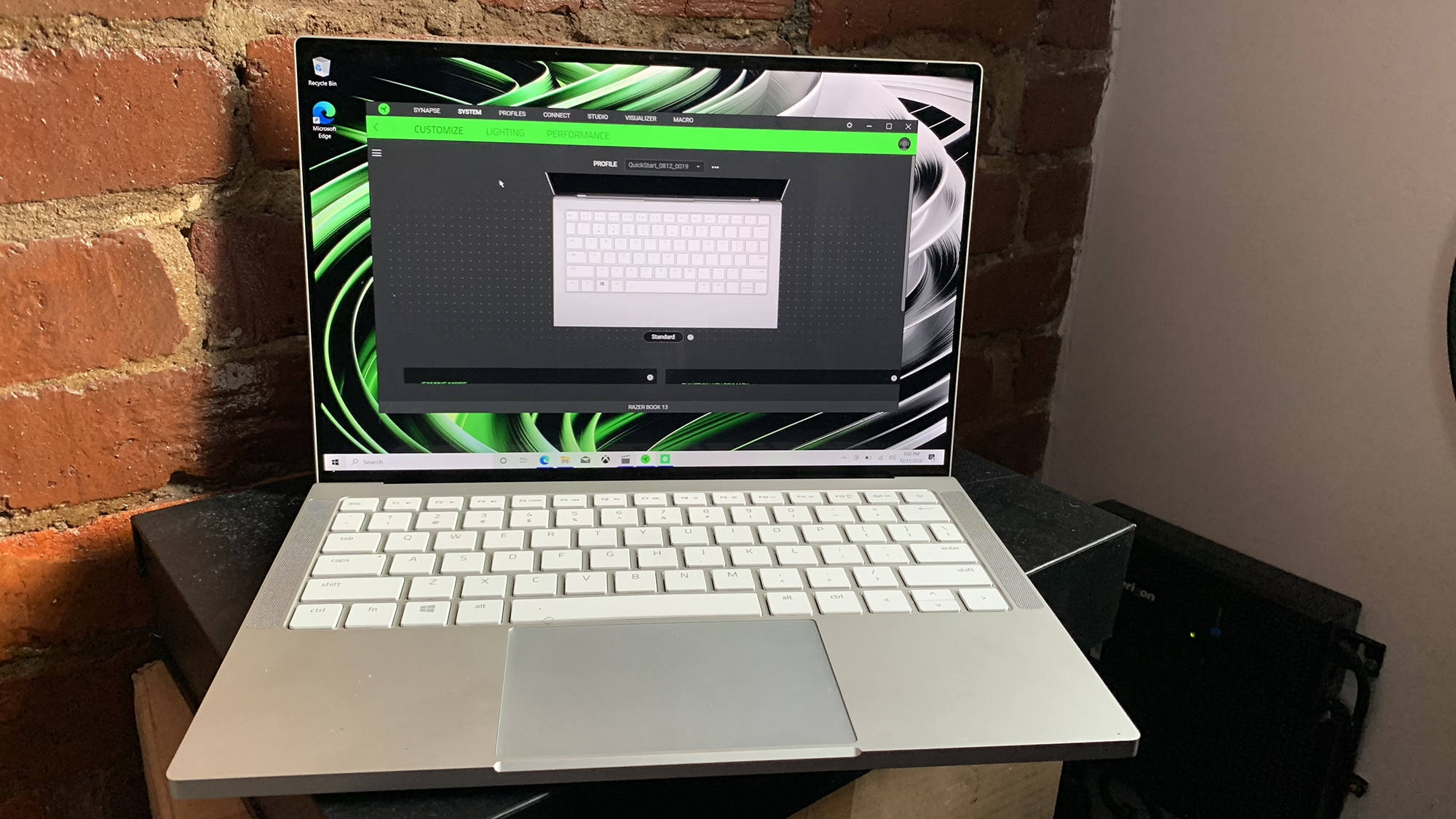
But the Razer Book 13’s keyboard doesn’t just look good, it feels good to type on, delivering firm, snappy feedback. The keys are large enough to support the chunkiest fingers. The Backspace and Enter keys aren’t as large as I would like, but they get the job done. I reached my normal 70 words per minute on the 10fastfingers typing test.
The 4.4 x 2.7-inch glass touchpad is nice and big. It accurately performed all the expected Windows 10 gestures including pinch-zoom, two-finger scroll and three-finger tap.
Razer Book 13 performance
The Razer Book 13 is the latest system to make the jump to Intel’s new Tiger Lake processor, which offers better performance and endurance. The Razer Book 13 has a 2.8-GHz Intel Core i7-1165G7 CPU, 16GB of RAM and a 256GB M.2 PCIe SSD. I watched Jingle Jangle for the third time on Netflix with 35 additional Google Chrome tabs, some running Twitch, YouTube and Tweetdeck. My holiday spirit didn’t experience any lags despite everything going on.
We also saw positive performance during our synthetic test as well, starting with the Razer Book 13 scoring 5,460 on the Geekbench 5.0 overall performance test. That’s better than the 4,104 premium laptop average, the ZenBook 13 (5,084) and the XPS 13 (5,254), both of which also have a Core i7-1165G7 processor. However, the MacBook Pro with its Apple M1 SoC managed 5,882.
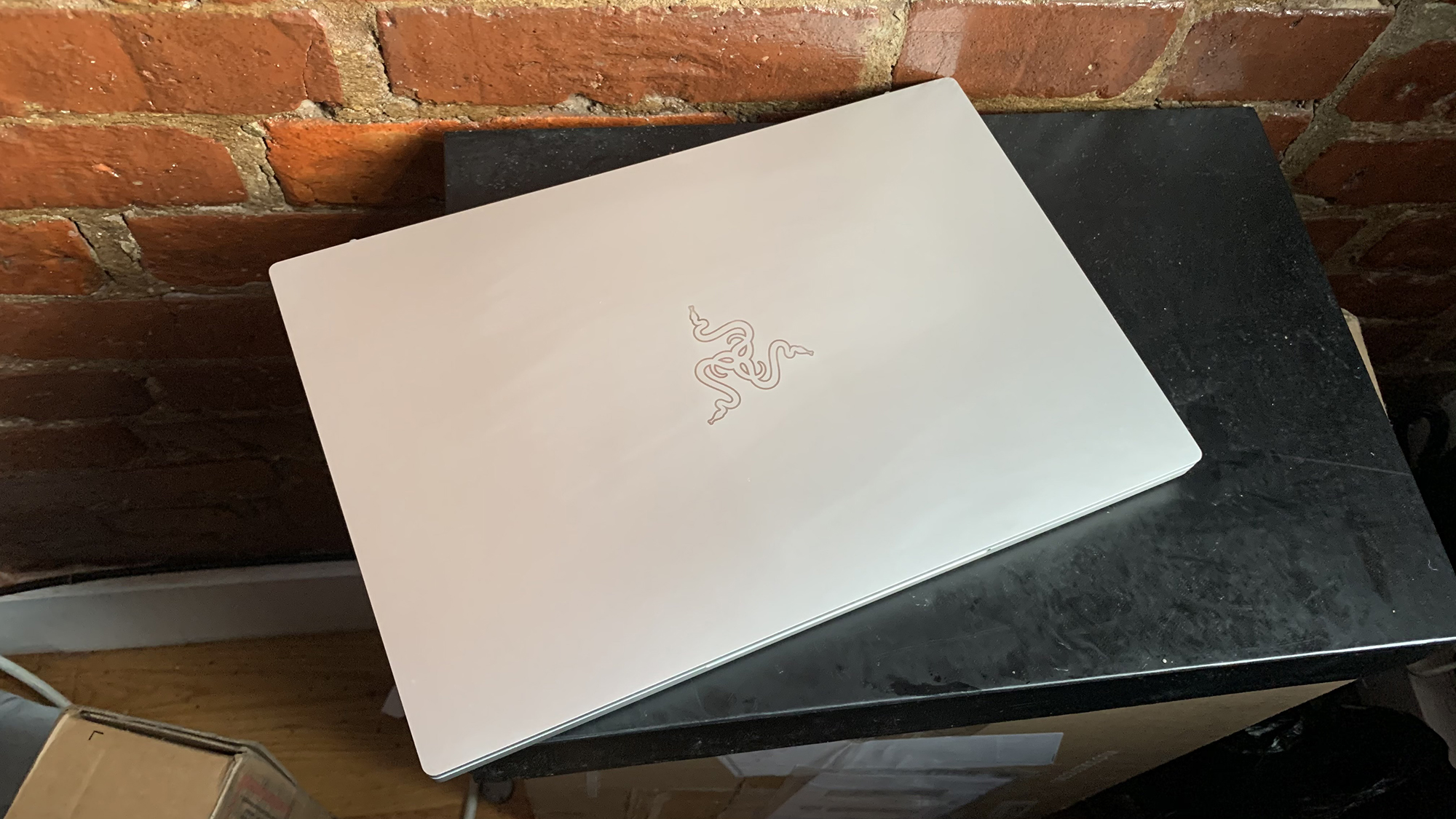
When we ran the Handbrake video transcoding test, the Razer Book 13 took 14 minutes and 46 seconds to transcode a 4K video to 1080p. Again, it surpassed the category average (17:33), ZenBook 13 (17:51) and XPS 13 (18:22), but not the MacBook Pro, which had a time of 13:38.
During the Puget Photoshop test, which loops through 21 different Photoshop tasks three times per run, the Razer Book 13 scored 695, beating the 607 average. The result was enough to top the XPS 13’s 588 as well as the MacBook Pro (649). The ZenBook 13 achieved 742.
On the File Transfer Test, the Razer Book 13 had a transfer rate of 364.4 megabytes per second. It was well below the 565.9MBps average. The ZenBook 13’s 1TB M.2 PCIe 3.0 SSD notched a faster rate of 583.6MBps as did the XPS 13 (512GB M.2 PCIe NVMe SSD), which netted 806.2MBps.
Razer Book 13 graphics
The Razer Book 13’s integrated Intel Iris Xe Graphics GPU did a bang-up job on our graphics testing. For instance, the laptop notched 5,216 on the 3DMark Fire Strike benchmark. It defeated the ZenBook 13 (4,407) and XPS 13 (3,598), both of which have their own Iris Xe Graphics. It also crushed the 4,153 premium laptop average.
When we ran the Sid Meyer’s Civilization VI: Gathering Storm benchmark at 1920 x 1080, the Razer Book 13 obtained 29 frames per second, matching the MacBook Pro (Apple M1 GPU). The result was enough to sail past the 28-fps category average. The ZenBook 13 hit 21 fps while the XPS 13 reached 16 fps.
Razer Book 13 battery life
The advent of Intel Tiger Lake brings Intel Evo, the second stage in the company’s Project Athena initiative. Evo comes with a number of requirements for laptops to receive Intel’s certification. One of those is at least 9 hours of battery life for 1080p systems. The Razer Book 13 lives up to that and then some, lasting 11 hours and 44 minutes on the Laptop Mag Battery Test (continuous web surfing over Wi-Fi at 150 nits of brightness). It’s the longest battery life we’ve ever seen on a Razer laptop.
It surpassed the 9:56 premium laptop average and the XPS 13’s 11:07. However, the ZenBook 13 and MacBook Pro lasted 13:47 and 16:32, respectively.
Razer Book 13 heat
The Razer Book 13 remained cool under pressure for the most part thanks to the company’s patented vapor chamber cooling system. After 15 minutes of running a fullscreen video, we measured the strategic points on the laptop. The touchpad and center of the system reached 86 and 94 degrees Fahrenheit, respectively. Both temperatures were cooler than our 95-degree comfort threshold. The bottom of the notebook, however, was warmer at 103 degrees.
Razer Book 13 webcam
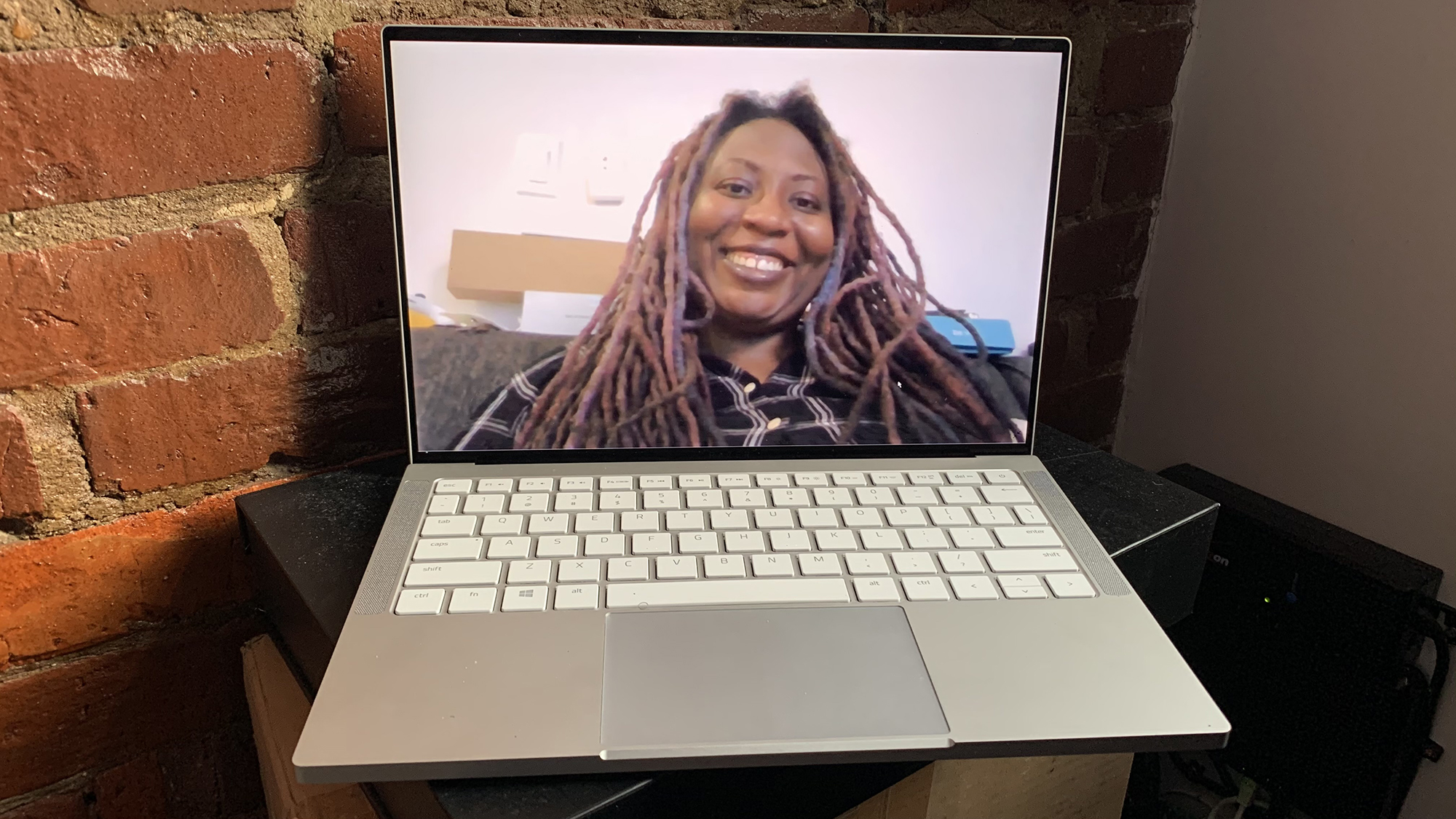
The Razer Book 13’s 720p webcam captures decent images and can get the job done when it’s time for a video conference. In the test shots I took, the webcam captured the fading blue and purple in my locs, but failed to capture the pink in my plaid shirt. Still, the details were just clean enough that I could read “be well” printed on the light blue box in the background.
For crystal-clear results, you should invest in an external webcam.
Razer Book 13 software and warranty
Like most of its laptops, Razer keeps the bloatware on the Razer Book 13 to a minimum. You do, however, have the company’s Synapse software to program the lighting, macros, adjust the display refresh rate and set the Fn key row, among other things. Third-party software includes Hulu, Roblox and Dolby Access.
The Razer Book 13 ships with a 1-year limited warranty. See how Razer fared on Tech Support Showdown and Best and Worst Brands, our annual special reports.
Bottom line
Since its inception, Razer has been all about bucking expectations, especially once it got into laptops. And now that it’s got a firm grasp in the gaming space, the company is doing it once again with the Razer Book 13, a laptop designed with productivity users in mind. And it’s a serious force to be reckoned with.
For $1,599, you get a laptop clad in Razer’s stylish design with Intel’s new Tiger Lake processor and Iris Xe Graphics, which makes for a heady combination. The laptop stands toe-to-toe with more established brands in the space, many times surpassing them. And unlike its gaming brethren, the laptop cracked double-digits for battery life, making it the longest-lasting Razer laptop. Plus, you’ve got that bright, vibrant display and those beautiful, programmable keys.
However, the Razer Book 13 does have a few flaws, such as a sluggish SSD and a somewhat heavy chassis. If you’re looking for a laptop with better performance and battery life, you’ll want to check out the $1,899 Apple MacBook Pro (13-inch, M1). Or if you’re a Windows 10 fan, the $999 Asus ZenBook 13 UX325EA might be more your flavor. But if you’re looking for a non-gaming Razer laptop packing impressive power, the Razer Book 13 is a must-have.

Sherri L. Smith has been cranking out product reviews for Laptopmag.com since 2011. In that time, she's reviewed more than her share of laptops, tablets, smartphones and everything in between. The resident gamer and audio junkie, Sherri was previously a managing editor for Black Web 2.0 and contributed to BET.Com and Popgadget.
